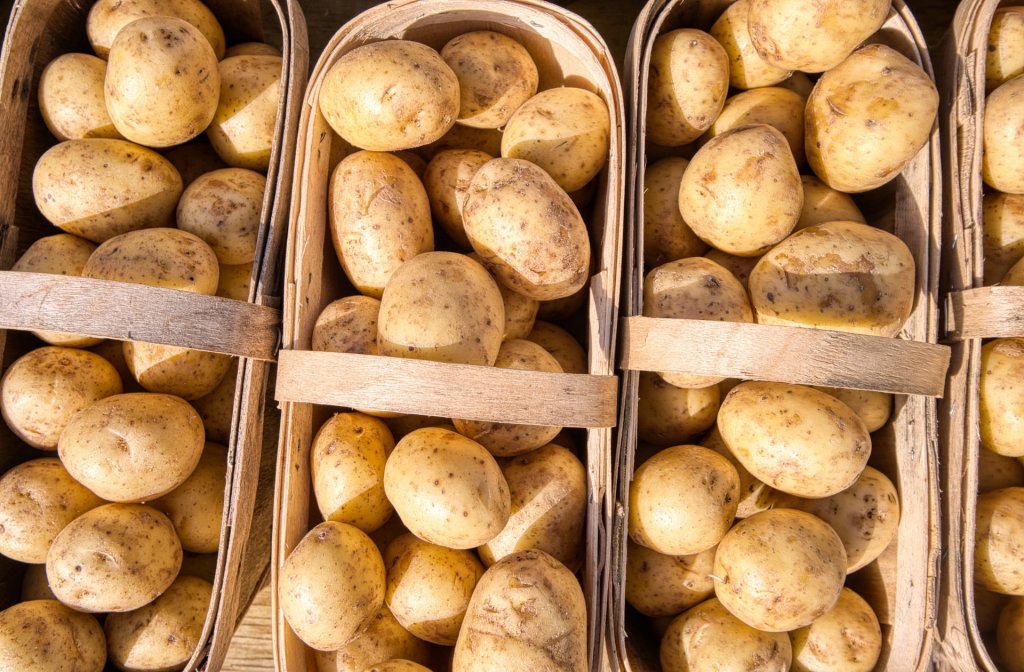In this article, we’ll cover the following topics all about resistant starch:
- What Exactly Is Resistant Starch?
- The Different Types of Resistant Starch Explained
- What Are the Health Benefits of Resistant Starch?
- How to Enjoy the Health Benefits of Resistant Starch Yourself
- Optimize Your Diet Based on Foods High in Resistant Starch
- Supplement With Resistant Starch Powder to Fill in the Gap
- Final Thoughts on the Benefits of Resistant Starch
The Health Benefits Of Resistant Starch
Despite the stiff and, well, starchy name, there are actually countless health benefits of resistant starch. The name, we realize, doesn’t exactly scream magic silver bullet. “Resistant” conjures up all sorts of moody teen energy. And “starch”… well, aren’t starchy carbs bad for you?
But the truth is: resistant starch is an often-overlooked yet hugely vital nutrient that has some major health benefits. The power it has to rebalance your gut and improve your overall health is not only perspective-shifting, it’s truly life-changing.
While the science is still relatively new (if you consider 30 years of research and over 200+ clinical studies “new” that is), the ancestral history of resistant starch in our diets is anything but. For thousands of years, before the arrival of processed foods and even pre-dating agriculture, humans regularly consumed large amounts of resistant starch in the form of foods such as savanna tubers, roots, raw potatoes, green bananas, uncooked rolled oats, legumes, beans, and more. Today, the average American consumes only around 3-8 grams of resistant starch per day.
As you’ll soon see in our discussion, striving for a diet richer in resistant starch and more reminiscent of our ancestral eating patterns can have myriad health benefits across a broad spectrum of bodily functions.
What Exactly is Resistant Starch?

Resistant starch is a few things. It’s a specific type of carbohydrate. It’s a dietary fiber. It’s an unsung hero of digestive health and a secret missing ingredient from most people’s diets.
The most basic way to understand resistant starch is that it’s a type of dietary fiber that gets its name because it “resists” digestion in your small intestine and instead travels all the way to your colon to be broken down as food for the good bacteria in your gut.
A lot of carbohydrates deservedly get a bad wrap because they’re too easily digested. Simple carbs (like sugar, white flour, and other processed hallmarks of modern western diets) break down almost immediately in your digestive tract into glucose. This can lead to sugar spikes and sugar crashes, which are no bueno.
Resistant starch, on the other hand, is a prebiotic fiber, which means it skips the step of being broken down into glucose, and instead, travels intact all the way to your gut to nourish the friendly bacteria in your gut microbiome. Once there, the resistant starch ferments and metabolizes into short-chain fatty acids (SCFAs) like butyrate, which have all sorts of amazing benefits throughout the body. (Actually, in a lot of ways, SCFAs are where the magic happens!)
The Different Types of Resistant Starch Explained

Not all resistant starches are the same. In fact, at least four different types of resistant starch are widely recognized. And getting a healthy mix of each can lead to a harmonious digestive system.
RS1 = Found in grains, seeds, nuts, beans, and legumes, RS1 is starch that’s physically trapped in food by intact plant cell walls. In other words, the naturally occurring cell walls in these foods act almost as a kind of armor that’s strong enough to stop the small intestine’s digestive enzymes from breaking these foods down.
RS2 = Found in fermentable fibers like raw potatoes, green bananas, and raw plantains, RS2 foods avoid digestion not because their plant cell walls are strong, but because their entire molecular makeup is different.
- RS2 + Heat: The interesting thing about RS2 is that “heat” can alter the molecular makeup significantly. For instance, a raw potato is super high in resistant starch. When cooked, however, the tightly-bound glucose molecules within expand with heat, and then become much more easily digestible, which effectively transforms the potato from a great source of indigestible resistant starch to a much more simplified, digestible carb.
RS3 = Found in cooked-then-cooled starches such as potatoes, rice, pasta, and oats, RS3 is what’s called a “retrograde starch.”
- RS3 + Cold: Similarly to how the molecules of RS2 can be altered through heat, RS3 is a shapeshifter due to cold. For example, if you take that same potato that you heated up, and then put it in the refrigerator, the potato would once again return to having a higher concentration of resistant starch. Its molecular makeup wouldn’t be exactly the same to its pre-cooking form (which is why it’s considered a different kind of resistant starch) but the health benefits of RS3 are comparable.
RS4 = Created through novel modification, RS4 is a chemically derived form of resistant starch that doesn’t occur in nature, but that is formulated synthetically to resist digestion. (Or, as Chris Damman, our Chief Medical and Science Officer at Supergut, calls them: “Frankenstarches.”)
What are the Health Benefits of Resistant Starch?

On par with sleep and exercise, the health benefits of resistant starch simply cannot be overstated. From strengthening your immune system to improving energy levels and curbing hunger cravings, there are numerous health benefits of resistant starch.
Here are just a handful of the unique health-promoting ways this powerhouse prebiotic dietary fiber helps your body.
Better Gut Health
Put simply, gut bacteria gotta eat. Trouble is, they’re not a very picky bunch; they’ll eat just about anything. Feed them a typical western diet of highly processed and easily digestible foods, for instance, and you’re bound to attract a menacing cohort of monocultural bacteria. This is bad-news-bears for your gut health because, in the world of adult gut bacteria, “uniformity” is public enemy number one.
A healthy gut ecosystem needs diversity. That’s why you often hear the term “rebalancing your gut” — because you’re effectively trying to re-shape the makeup of your gut ecosystem by cutting down on the types of inflammatory bacteria that love highly-processed foods, and instead boosting overall microbial diversity and increasing the number of healthy bacteria that produce SCFAs.
A diet consisting of dietary plant fibers and foods high in resistant starch is one of the best, most surefire ways of not only nourishing your already-existing good gut bacteria but also increasing their numbers and optimizing your overall gut health. Resistant starch is even linked with helping to reduce the risk of colon cancer.
And as we all know (or are beginning to learn), good gut health leads to good overall health.
Regulated Digestion

It makes sense, right? Better gut health equals better bowel movements. The unfortunate reality is that 70 million Americans suffer from digestive issues, from heartburn to gas and bloating to constipation.
Thankfully, it doesn’t take some highly complex treatment plan or wonder drug to improve your digestive health. Functional foods like fiber and resistant starch can perform that role better than anything modern science has to offer. In fact, incorporating foods high in resistant starch into your diet can improve digestion, minimize bloating and IBS symptoms (since resistant starches are considered low FODMAP), and yep, keep you regular.
Boosted Immune System
Did you know that about 70% of your immune system lives in your gut? In other words, the majority of the time we get sick is because our gut microbiomes were already compromised. This makes sense when you consider that only 12% of Americans are considered metabolically healthy. With our highly-processed westernized diets, we’re as a society effectively just giving viruses and bacterial infections a head start in their race against our immune-boosting cells.
So, a simple fix for ensuring your immune system is better prepared for “race day”? Use food itself as medicine! Opting for a diet high in whole foods and plant fiber — and yep, you guessed it, resistant starch — can spark the production of short-chain fatty acids (SCFAs) such as butyrate, which can, in turn, boost your immune system and reduce your risk of infections by improving gut barrier function and inflammatory processes.
Healthy Blood Sugar Control
Our microbiome plays a hugely important role in regulating blood sugar and insulin. And resistant starch itself is a serious superpower when it comes to helping you avoid sugar spikes and crashes. In fact, numerous studies show that resistant starch can reduce glycemic response to foods, improve insulin sensitivity, maintain blood sugar control, and enhance first-phase insulin secretion from the pancreas.
Normally, most of the carbohydrates we eat are immediately digested. This causes a natural breakdown of glucose (aka, a spike in blood sugar). Resistant starches, on the other hand, mimic fasting in that they’re not immediately digested and therefore don’t cause this spike.
By regularly consuming more resistant starch in your diet, you can improve insulin sensitivity both in the short term as well as actually reduce your average blood sugar levels (A1C) over time. Maintaining healthy blood sugar control can limit (or even prevent) the effects of diabetes. And since high blood sugar is often associated with chronic fatigue, the inverse result of having healthier blood sugar means you can prevent fatigue and sustain energy levels for longer. Say so long to midday sluggishness!
Lower Cholesterol & Better Heart Health

Who knew heart health could be directly tied to your gut? Sure enough, studies show that resistant starch can help reduce serum cholesterol and LDL-C levels. As we all know, high cholesterol can increase your risk of heart disease. The good news is that highly fibrous starchy foods such as oats and other resistant starches can reduce the absorption of cholesterol and sugar in your intestinal tract.
Another way resistant starches can help with heart health is by improving blood pressure. As we’ve mentioned, the fermentation process of good bacteria feeding on undigested fibers in your colon releases a series of small molecules called short-chain fatty acids (SCFAs), like butyrate. Now, studies are beginning to emerge that suggest a higher level of butyrate in your colon is actually associated with lower blood pressure.
Improved Weight Control
As we all know, the algebra behind weight control can be a tricky equation. For years, the standard science suggested that metabolism was primarily governed by calories-in and calories-out. But the truth is much more complex than that. And actually, bacteria play a much larger role in weight loss than we previously thought.
In many ways, bacteria are like the workhorses of human health. They break down food, extract nutrients, create byproduct health messengers like SCFAs, and more. Our food is their food. So, when we provide our microbiome bacteria with high-quality foods that are high in resistant starch, we’re effectively helping them better perform their jobs.
In other words, resistant starch helps with weight control in a few different ways. It feeds these good bacteria to better help with digestion and gut health. It also increases your feeling of fullness and reduces overall appetite when combined with protein and other prebiotic fibers. Because it’s digested very slowly in your gut, resistant starch makes you feel full and satisfied for longer, curbing cravings in the process. Talk about a win-win!
How to Enjoy the Health Benefits of Resistant Starch Yourself

The best way to enjoy the health benefits of resistant starch is through your diet.
And the really cool thing about resistant starch is that you don’t have to do much to reap the rewards. Once you take the initial step of choosing foods high in fiber and difficult-to-digest starches, your work is pretty much done! From there, you can mostly just sit back, relax, and let the little guys in your gut take over.
Optimize Your Diet Based on Foods High in Resistant Starch
Many types of food contain resistant starch. Foods such as uncooked/unprocessed grains, intact whole grains, green bananas, and high-amylose potato starch are all high in resistant starch.
Examples of foods high in resistant starch include:
- Uncooked rolled oats
- High-amylose maize or corn starch
- High-amylose potato starch
- Cooked, then cooled rice, pasta, or potatoes
- Whole grains
- Legumes
- Under-ripe green bananas
To optimize your diet with foods high in resistant starch, try to incorporate a variety of whole foods and dietary fibers such as uncooked rolled oats, under-ripe/green bananas, raw potatoes, legumes, nuts, beans, and seeds.
Supplement With Resistant Starch Powder to Fill in the Gap

What is resistant starch powder? Glad you asked! As we’ve seen, most people don’t get enough fiber or resistant starch naturally in their diets — only about 5% of people get enough adequate fiber intake!
As we’ve also seen, the foods that are high in resistant starch are, frankly, kind of a tough sell! How many times have you craved a really under-ripe green banana, for instance? Or wanted to cook a bowl of rice only to then refrigerate it and eat the rice cold? Or do the same with a potato?
The truth is, getting enough resistant starch naturally in your diet is difficult. That’s where food products such as Supergut come in. Across our suite of superstar Supergut products — which, by the way, have been clinically shown to improve your overall metabolic health — is a flavorful mix of Gut Balancing Shakes, Bars, and an Add-to-Anything Fiber Mix — all of which can be easily added to your diet to help you consume the recommended daily intake of prebiotic fiber and resistant starch.
Final Thoughts On the Benefits of Resistant Starch
Resistant starch isn’t some flashy fad or trend; it’s a longstanding (even if long-forgotten) superfood and a true game-changer when it comes to improving your gut health.
As numerous scientific studies have shown, when you improve your gut health, you improve your overall health — from healthier blood sugar and lower cholesterol to better immunity and higher energy levels.
When we take care of our guts, they take care of us. So, whatever you do — don’t resist resistant starch!








